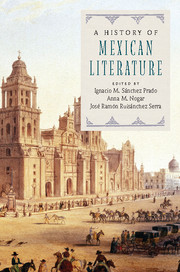Book contents
- Frontmatter
- Contents
- List of contributors
- Introduction
- PART I COLONIAL LITERATURE
- PART II THE NINETEENTH CENTURY
- PART III TWENTIETH AND TWENTY-FIRST CENTURIES
- PART IV MEXICAN LITERATURE BEYOND BOUNDARIES
- 25 The Literatures of Greater Mexico
- 26 Indigenous Literatures of México
- 27 Writing Cinema: The Communicating Vessels of Literature and Film
- 28 Popular Narratives: Telenovelas, Corridos, Historietas, and Other Literary Pursuits
- Index
- References
25 - The Literatures of Greater Mexico
from PART IV - MEXICAN LITERATURE BEYOND BOUNDARIES
Published online by Cambridge University Press: 05 July 2016
- Frontmatter
- Contents
- List of contributors
- Introduction
- PART I COLONIAL LITERATURE
- PART II THE NINETEENTH CENTURY
- PART III TWENTIETH AND TWENTY-FIRST CENTURIES
- PART IV MEXICAN LITERATURE BEYOND BOUNDARIES
- 25 The Literatures of Greater Mexico
- 26 Indigenous Literatures of México
- 27 Writing Cinema: The Communicating Vessels of Literature and Film
- 28 Popular Narratives: Telenovelas, Corridos, Historietas, and Other Literary Pursuits
- Index
- References
Summary
The term “Greater Mexico” is a core formulation in the thought of Texas scholar Américo Paredes. There is general agreement among Mexican American scholars that the idea gave rise to the first phase of Chicano Studies. With this term, Paredes explains, he meant: “all the area inhabited by people of Mexican culture – not only within the present limits of the Republic of Mexico but in the United States as well – in a cultural rather than a political sense” (Paredes, 1976: xiv).
Respecting the heteroglossic nature of the writings produced by these same people, it is necessary to account for writing as a legacy on both sides of what is today the U.S.-Mexico border as of the colonial period. Introduced into Greater Mexico during the Spanish colonial era, writing took a wide variety of forms, such as chronicles, books, broadsheets, religious-devotional imprints, décimas, popular verse forms, and baroque oratory. Most texts produced in this period had a workmanlike quality inasmuch as the ideas they contained were often the result of exigency rather than leisurely endeavor. Despite their ephemeral nature, these texts would effectively traverse Greater Mexico with the ideas that entered into the thinking of borderlands inhabitants. It is not unrealistic to consider that Spaniards, Creoles, mestizos, and Indians, whether in endogamous or exogamous exchanges, would find themselves, at one time or another during this period, remarking on baroque ideas, signs, and symbols in everyday speech and conversations.
Writing as a technology was instated prior to the publication of Álvar Núñez Cabeza de Vaca's La relación (1542), a text that would come to be representative of early European contact with the region. This memoir-chronicle recounts the wanderings of the four survivors of a failed Spanish expedition to Florida, as they crossed the interior of North America, a journey that lasted from 1527 to 1539.
The book comes alive through the painful details of the four castaways surviving hurricanes and shipwrecks; living among the natives as a traders, healers, and slaves; and eventually coming to lead large groups of people on a series of pilgrimage-like quests that end with an unintentional return to Spanish-held territories in present-day Sinaloa.
- Type
- Chapter
- Information
- A History of Mexican Literature , pp. 381 - 396Publisher: Cambridge University PressPrint publication year: 2016



